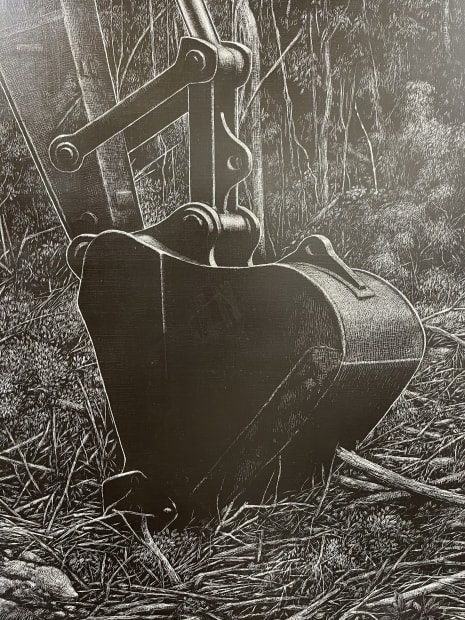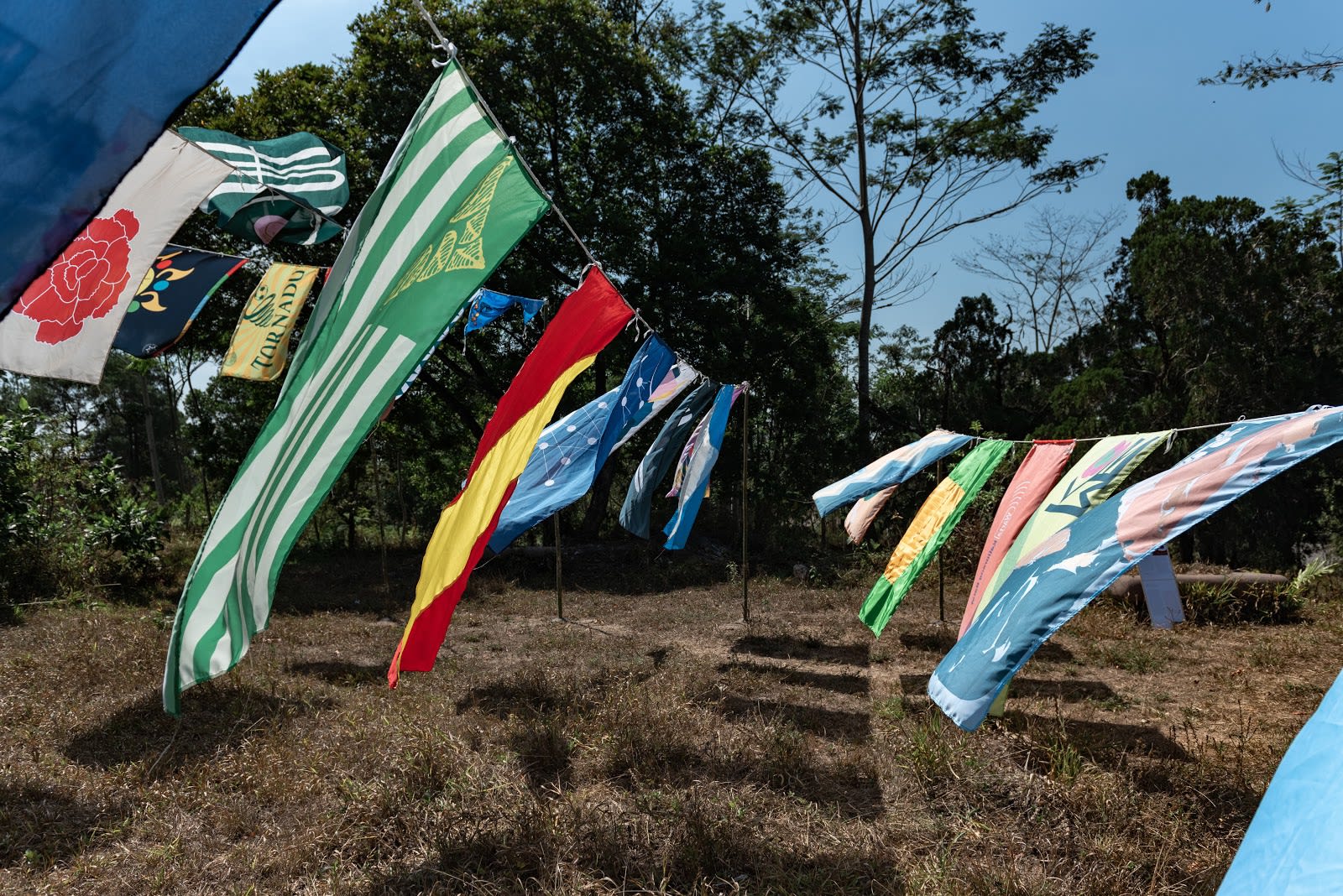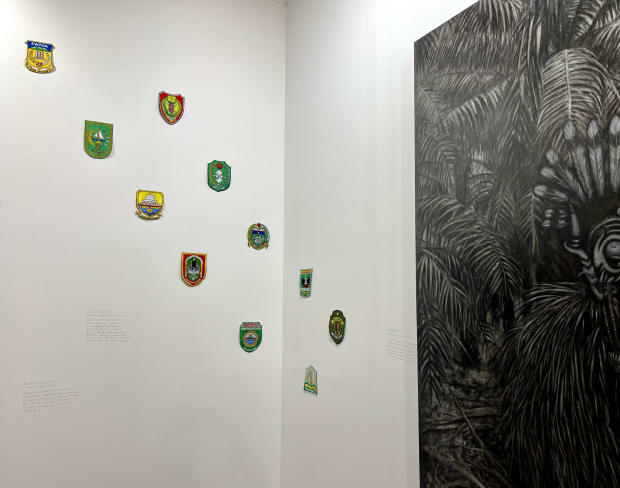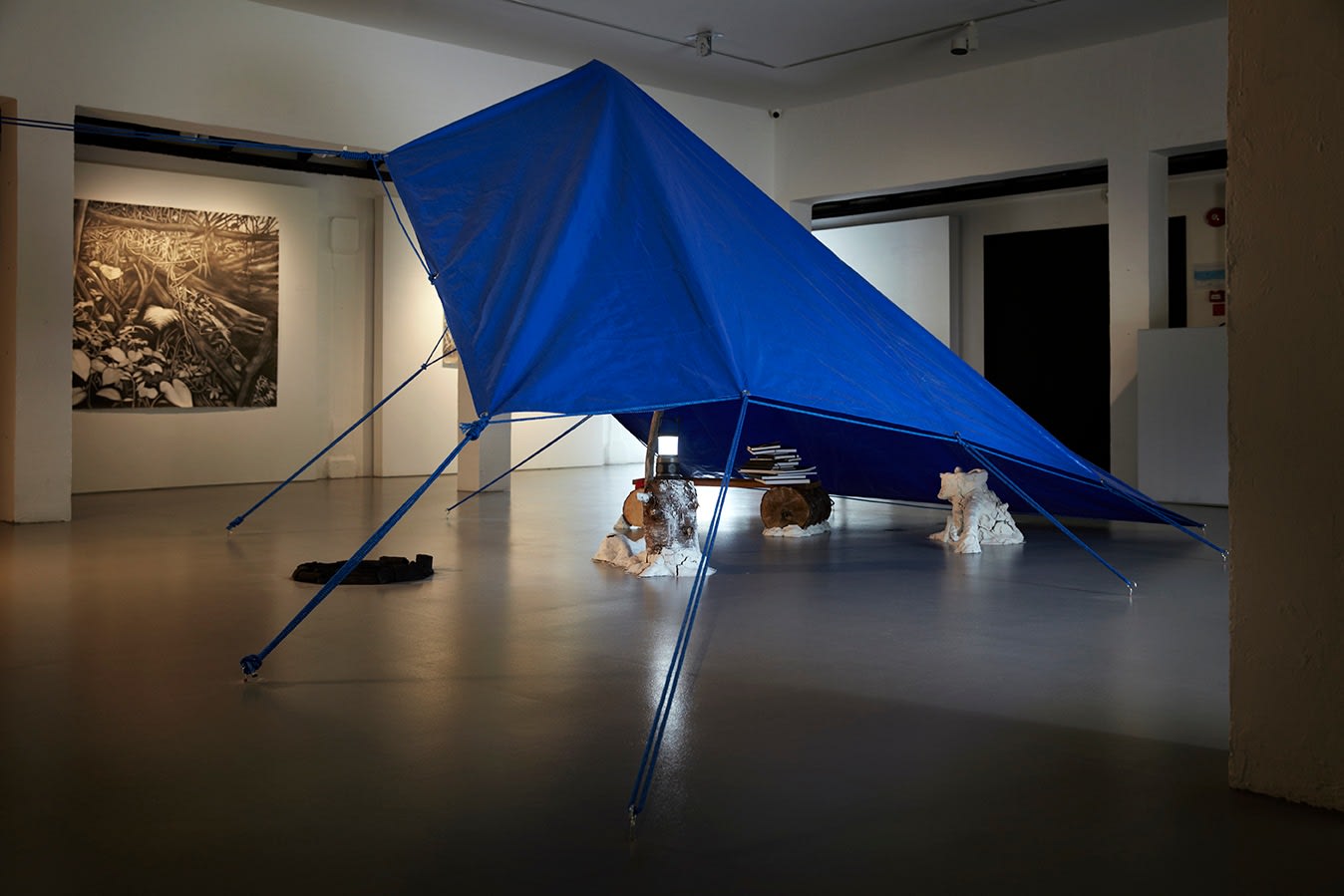-

-
Deeply concerned about geo-political and environmental issues around Southeast Asia, particularly his home country Indonesia, Maryanto creates evocative monochrome paintings, drawings, and installations that remind us of underlying power hierarchies that invisibly demarcate our lands. On the occasion of Art Dubai 2023, Maryanto has developed a new body of work specially for Bawwaba, a section curated by independent curator Vipash Purichanot spotlighting notable artists from the Global South.
Expanding on his past research into various areas of exploitation in Indonesia such as volcanic sand mining around Mount Merapi and oil dredging in Wonocolo, East Java, Maryanto continues to bring attention to environmental issues in the country. This time, he sheds light on the rampant development of palm oil plantations in South Kalimantan and the gradual encroachment of its forests as a result. Indonesia is the largest exporter of palm oil, accounting for 68% of the world’s palm oil production. At the same time, he touches on the themes of transmigration, ownership, and capitalism. While he does not set out to frame his practice as environmental activism, Maryanto considers his works as aspirational: bringing public awareness to issues that he is not able to change on his own.
-
-
-
 Maryanto, Palm Spirit, 2023, Charcoal on canvas, 210 x 150 cm
Maryanto, Palm Spirit, 2023, Charcoal on canvas, 210 x 150 cm -

-
Fresh Fruit Bunch (2023) depicts a scene that appears in the documentary film charting Maryanto’s journey to the Kalimantan forests and interacting with the indigenous people there to understand the extent of destruction happening in the region. He brings attention to the issue of transmigration in Borneo, which has in part resulted in the transformation of the island’s landscape. In the 1970s, the government introduced the notion of land ownership and the issuance of permits to businessmen, which led to a surge of companies from outside Kalimantan arriving and clearing the swaths of forests for cultivation. The Plasma Program was launched to support transmigrant communities to establish their own palm oil plantations and gain ownership of the land. Eventually, more land was cleared to make room for these new settlers or transmigrants.
However, land ownership and Forest Processing Rights are at odds with the beliefs of the indigenous people. To them, these lands belong to no one. They are not property that could nor should be owned by individuals or companies. Despite this, many locals have started to plant palm oil too, seeing the success and prosperity of the transmigrants. The land-respecting way of life has ultimately given way to a consumerist and capitalist mindset.
-
-
The rife deforestation in South Kalimantan is brought to bear in Maryanto’s black and white paintings. When The Trees Fall (2023) captures the now quotidian moment of the area. A master of the scratching technique and widely respected amongst the artist community in Yogyakarta, Maryanto undermines the romantic language of traditional landscape painting to examine socio-political structures in the physical spaces that he depicts. They act as a subversive reference on historical books published during the colonial period, where the Dutch Indies had used the natural landscapes to promote the beauty of Indonesia as propaganda.
During Maryanto’s time in South Kalimantan, he also learned of the illegal logging operations taking place. He encountered a group of loggers from the local community there, who shared the constant perils of timber theft. While it has not reached the customary forests of the indigenous people, it remains a potential threat that they have to mitigate. Locals are actively fighting for the recognition of these forests in order to gain legal protection for them. When The Trees Fall (2023) inevitably raises the philosophical thought around the unobserved phenomenon: ‘If a tree falls in a forest and no one is around to hear it, does it make a sound?’ Though the dredging of forests in Kalimantan is discernibly felt and experienced by the locals on a daily basis, it occurs without the scrutiny of the rest of the world. -
Maryanto, ‘’Rukun Tresna” (Harmonious and Affectionate)’, 2019, site-specific installation for 900mdpl
-
 Maryanto, Palm Oil District, 2023, 21 x 15 cm x 11 pcs, Embroidery, installation on wall
Maryanto, Palm Oil District, 2023, 21 x 15 cm x 11 pcs, Embroidery, installation on wall -
 Maryanto, Palm oil in daily life, 2023
Maryanto, Palm oil in daily life, 2023 -
Each province in Indonesia carries their own unique saying, mostly written in antiquated vernacular. For Becoming Palm (2023), Maryanto borrows the vocabulary from ancient Borneo literature that is no longer used in modern day. “Bujur banar ruhui rahayu” loosely translates to “it is really peaceful and serene-harmonious” and can be understood as a saying in East Kalimantan to describe the serene beauty of the environment. Yet its regional symbol only features the latter words ‘ruhui rahayu’. The story behind its abridged adaptation was said to be that the region’s leader had studied in West Java (Sudan) and ‘bujur’ means ‘ass/arse’ in Sudanese.
These words are placed in stark contrast to the scenery Maryanto has depicted, which reveals the reality of the Kalimantan forests and its extensive devastation. He imitates the Mooi Indie style of painting, which was the à la mode to promote the scenic landscapes of Asia before photography was popularised and is now often seen in the national collections in Europe. It draws a connection to the Dutch colonial period that had first introduced the development of plantations, transmigration, and land ownership in Indonesia, where postcards of these scenic landscapes were often sent back home in request for more financial assistance to develop the plantations. Lamenting the irrevocable ruin of the forests in present-day, Maryanto subverts this idea as a plea for corporations to stop pumping investments to its lands. He recalls a Javanese proverb that encapsulates the struggles of the community in its earnest pursuit for tranquillity, fertility, prosperity, and nobleness: gemah ripah loh jinawi. -
 Maryanto, Becoming Palm “BUJUR BANAR RUHUI RAHAYU (it’s really serene and harmonious)”, 2023, Charcoal on fabric, 100 x 300 cm
Maryanto, Becoming Palm “BUJUR BANAR RUHUI RAHAYU (it’s really serene and harmonious)”, 2023, Charcoal on fabric, 100 x 300 cm -
On a more intimate scale than his monochromatic paintings, Maryanto created these 9 scratchings on photo paper. Some of the compositions here recall the scenes in the adjacent documentary video work, where idyllic and sacred moments are placed in contrast to the violence and disruption brought about by palm oil and coal mining industries.
-
Previous installations by Maryanto
-
Maryanto | When The Trees Fall
Past viewing_room





















